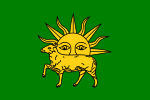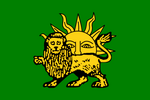Physical requirements for the Iranian flag, the exact shape of the emblem, and a
compass-and-straightedge construction are described in the national Iranian standard.
[1]
History
| Iranian flags |
|---|
| Historical |
|---|
|
|
|

flag of Persia (1910-1925)
|
Flags, standards, and banners have always been important national and imperial symbols for
Iranians, both in war and peace.
Xenophon reports that
Cyrus the Great's standard was a golden eagle with spread wings, mounted on a long shaft.
The best-known symbol of Iran in recent centuries has been the
Lion and Sun motif, which is a graphic expression of the astrological configuration of the
sun in the sign of
Leo, although both celestial and animal figures have long and independent histories in Iranian heraldry. Late in the nineteenth century the Lion and Sun motif was combined with an earlier scimitar motif and superimposed on a tricolour of green, white, and red. With minor modifications, this remained the official flag until the revolution of 1979.
Achaemenid empire
During the
Achaemenid era, especially at the time of
Cyrus the Great, the Persian imperial flag was rectangular in shape, divided kite-like into four equal triangles alternating between two colors.
In the excavations at
Persepolis archaeologists found a standard depicting a golden eagle (
oghabe talaii) with open wings. The current belief is that this was the official symbol of Iran under Cyrus the Great and his heirs.
Sassanid empire
In
Sassanid times the imperial flag was a leather rectangle covered with a thin layer of silk ornamented with jewels, with a four-pointed star at the centre, indicating the four corners of the world. This is the same star referred to as
Akhtare Kaviani ("the Kaviani star") by
Ferdowsi in the epic
Shahnameh (
Book of Kings). The flag was larger than the original Derafshe Kaviani apron and suspended from a lance, the point of which appeared above it. Attached to the lower edge were tassels of yellow, magenta, and scarlet, with large pendant jewels. The flag was destroyed by invading Muslim Arabs after their decisive
defeat of the Sassanids.
Islamic Iran
The Sassanid state collapsed on the emergence of an Islamic empire in the Middle East. Since Islam strictly prohibited figurative and expressive symbols as
idol worship, all the traditional emblems used in Iranian flags were eliminated
[citation needed]. Throughout this period there was no flag specific to Iran, although the use of Islamic banners was common
[citation needed].
Ghaznavid dynasty
Mahmud of Ghazni (998–1030) reinstated the use of symbolic expressions on the Iranian flag; the version he developed displayed a golden moon on a black background. A second flag has been attributed to the Ghaznavid empire, with a silver crescent moon and a peacock on a green field.
[2]
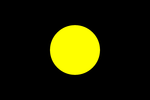 |
| Reconstruction of the flag adopted by Mahmud (998–1030) |
|
Safavid dynasty
The
Safavid Dynasty (1501–1736) used three green flags, each with a different emblem.
Ismail I, the first Safavid king, designed a green flag with a golden full moon. In 1524
Tahmasp I replaced the moon with an emblem of a sheep and sun; this flag was used until 1576. It was then that
Ismail II adopted the first Lion and Sun device, embroidered in gold, which was to remain in use until the end of the Safavid era. During this period the Lion and Sun stood for two pillars of the society: the state and religion. Although various
alams and banners were employed by the Safavids (especially during the reign of the first two kings), by the time of
Shah Abbas I the Lion and Sun symbol had become one of the most popular emblems of Iran.
The Safavid interpretation of this symbol is believed to have been based on a combination of historical legends like the
Shahnameh, stories of prophets, and other Islamic sources. For the Safavids the king (
shah) had two functions: he was both a ruler and a holy personage. This double role was considered the patrimony of the Iranian kings, derived from
Jamshid, mythical founder of the ancient Persian kingdom, and
Ali, the first
Shi'a Imam. Jamshid was associated with the sun and Ali with the lion (from his epithet "Lion of God"). The correspondence may originally have been based on a learned interpretation of the
Shahnameh references to "the Sun of Iran" and "the Moon of the Turanians". Since the crescent moon had been adopted as the dynastic (and ultimately national) emblem of the Ottoman sultans, who were the new sovereigns of
Rum, the Safavids of Iran, needing to have a dynastic and national emblem of their own, chose the Lion and Sun motif. The sun had further important meanings for the Safavid world, where time was organized around a
solar calendar, in contrast to the Arabo-Islamic
lunar system. In the
zodiac the sun is linked to Leo; for the Safavids the Lion and Sun symbol conveyed the double meaning of the royal and holy figure of the
shah (Jamshid and Ali), the auspicious astrological configuration bringing the cosmic pair and the earthly—king and
imam—together.
Regarding the Safavid understanding of the Lion and Sun motif, Shahbazi suggests that "the Safavids had reinterpreted the lion as symbolizing Imam ʿAlī and the sun as typifying the 'glory of religion', a substitute for the ancient
farr-e dīn." They reintroduced the ancient concept of God-given glory (
farr) to justify their rulership, attributing these qualities to Ali while tracing the king's genealogy through the fourth Shiʿite Imam's mother to the royal Sassanian house.
Afsharid dynasty
The
Afsharid dynasty had two royal standards, one with red, white, and blue stripes and one with red, blue, white, and yellow stripes.
Nader Shah's personal flag was a yellow pennant with a red border and a lion and sun emblem in the centre. All three of these flags were triangular in shape.
[3][4]
Nader Shah consciously avoided the using the colour green, as green was associated with
Shia Islam and the
Safavid dynasty.
[5]
Navy Admiral flag being a white ground with a red Persian Sword in the middle.
[6]
 |
| An Imperial Standard of the Afsharid dynasty |
|
 |
| Another Imperial Standard of the Afsharid dynasty |
|
 |
| Nader Shah's flag |
|
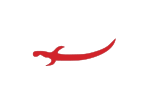 |
| Naval flag of Afsharid period |
|
Zand dynasty
The state flag of the
Zand dynasty was a white triangular pennant with a green border and a gold lion and sun in the centre.
[4]
 |
| Flag of the Zand Dynasty |
|
Early Qajar dynasty

Flag of Iran during
Fath Ali Shah’s reign in the early 19th century, depicted by Drouville
Unlike their Zand and Afsharid predecessors, the
Qajar rulers used rectangular flags. The flag of
Mohammad Khan Qajar was red with a gold lion and sun inside of a pale yellow circle.
[3]
Fat′h Ali Shah adopted a lion emblem on a plain red field as his
war flag. The main emblem was a lion
couchant in front of a sun, but a design featuring a lion
passant holding a sword was also in use.
[4] There was a green version of the flag for peace time and a white version for diplomatic purposes.
[7]
During the reign of
Mohammad Shah, the two different lion emblems were combined into a single flag which featured a lion passant holding a sword in front of a sun.
[4][4][5]
Under
Nasser al-Din Shah, the principal flag was white with a green border on three sides and a lion and emblem in the centre.
[8][9] There was also a naval ensign which had a red and green border and a civil ensign which looked the same as the naval ensign but without the lion and sun in the middle.
[8][10]
 |
| Flag of Mohammad Khan |
|
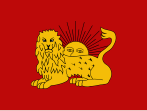 |
| War flag of Fat′h Ali Shah |
|
 |
| Diplomatic flag of Fat′h Ali Shah |
|
 |
| Peace flag of Fat′h Ali Shah (version with sword) |
|
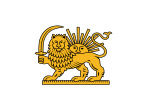 |
| Flag used during the reign of Mohammad Shah |
|
 |
| Tricolour flag designed by Amir Kabir |
|
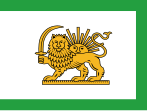 |
| State flag until 1906 |
|
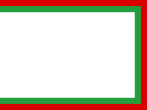 |
| Civil ensign until 1906 |
|
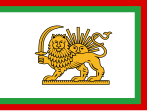 |
| Naval ensign until 1906 |
|
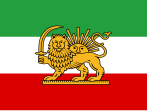 |
| Tricolour flag reported in 1886 |
|
Post-Constitutional Revolution
The first version of the modern Iranian tricolour was adopted in the wake of the
Iranian Constitutional Revolution of 1906.
[10] The
Supplementary Fundamental Laws of 7 October 1907 described the flag as a tricolour of green, white, and red, with a lion and sun emblem in the middle.
[11] A decree dated September 4, 1910 specified the exact details of the emblem, including the shape of the lion's tail ("like an italic S") and the position and the size of the lion, the sword, and the sun.
[12]
During this period, the colours of the flag were very pale, with the red appearing closer to pink in practice. There were three variants of the flag in use. The
state flag was a tricolour with the lion and sun emblem in the centre. The
national flag and
civil ensign was a plain tricolour with no emblem. The
naval ensign and
war flag was similar to the state flag, but the emblem was surrounded by a wreath and surmounted by a crown. All three flags had a 1:3 ratio.
[10]
The flag was modified twice during the
Pahlavi era. In 1933, the colours of the flag were darkened and the design of the emblem was changed. The sun's facial features were removed and the
Kiani Crown on the naval ensign was replaced with the
Pahlavi Crown.
[13] In 1964, the ratio was changed from 1:3 to 4:7 and the emblem on the naval ensign was shrunk to fit entirely within the white stripe.
[14]
Following the
Iranian Revolution, the
Interim Government of Iran removed the crown from the naval ensign. The old state and national flags remained unchanged until 29 July 1980, when the modern Iranian flag was adopted.
[15]
 |
| Naval ensign (1907–1933) |
|
 |
| National flag (1907–1933) |
|
 |
| State flag (1907–1933) |
|
 |
| Naval ensign (1933–1964) |
|
 |
| National flag (1933–1964) |
|
 |
| State flag (1933–1964) |
|
 |
| Naval ensign (1964–1979) |
|
 |
| National flag (1964–1980) |
|
 |
| State flag (1964–1980) |
|
 |
| Naval ensign (1979–1980) |
|
Islamic Republic

Current flag of Iran since 1980
In the constitution of 1980, Parliament changed the flag and seal of state. The Lion and Sun was succeeded by a new symbol, designed by Hamid Nadimi and officially approved by Ayatollah Khomeini on 9 May 1980, consisting of four
crescents and a line. The four crescents form the word Allah: read from right to left the first crescent is the letter
aleph, the second crescent is the first
laam; the vertical line is the second
laam, and the third and fourth crescents together form the
heh. Above the central stroke is a
tashdid (a
diacritical mark indicating
gemination) resembling a letter W. The tulip shape of the emblem as a whole memorializes those who have died for Iran and symbolizes the values of patriotism and self-sacrifice, building on a legend that red tulips grow from the shed blood of martyrs. A further change to the flag following the revolution was the addition of writing to the inner edges of the green and red bands, reading
Allahu Akbar ("God is great") in a stylized version of the
Kufic script used for the
Qur'an. There are 22 copies of this inscription, in two rows of eleven, symbolic of the 22nd day of the 11th month (
Bahman) in the
Persian calendar—the date of the Islamic revolution (22 Bahman 1357 = 11 February 1979 CE) that overthrew the Pahlavi dynasty. This addition of writing renders the flag non-reversible. By decree the Lion and Sun was removed from public spaces and government organizations and replaced by the present-day emblem of Iran.
To supporters of the Islamic revolution, the Lion and Sun symbol represented the "oppressive Westernizing monarchy" that had to be replaced, despite the emblem’s traditional Shi'a meanings and the lion's association with Ali.
[16] For that reason, the name of the
Red Lion and Sun Society was changed to
Red Crescent Society.
In the present day, the Lion and Sun is used by Iranian communities in exile as a symbol of opposition to the Islamic Republic. Some political groups, including monarchists and the
People's Mujahedin continue to use it as well. In
Los Angeles and other cities with large Iranian emigrant communities, the Lion and Sun appears on Iranian flags and souvenirs to an extent that far surpasses its display during the years of monarchy in its homeland.
[17]
[edit] See also
[edit] References
- ^ ISIRI 1 (in Persian)
- ^ flagspot.net Retrieved 1 Oct 2007.
- ^ a b "Flags of the World: Persia (Iran) from XVI to XVIIIth century". http://www.fotw.net/flags/ir_per16.html#qaj. Retrieved 11 November 2010.
- ^ a b c d e "The Lion and Sun Motif of Iran: A brief Analysis". http://www.kavehfarrokh.com/news/the-lion-and-sun-motif-of-iran-a-brief-analysis/. Retrieved 12 November 2010.
- ^ a b "Encyclopædia Iranica: FLAGS i. Of Persia". http://www.iranicaonline.org/articles/flags-i. Retrieved 12 November 2010.
- ^ Nādir Shāh's Campaigns in 'Omān, 1737-1744 By Laurence Lockhart, Bulletin of the School of Oriental Studies, University of London,Vol. 8, No. 1 (1935), pp. 157-171
- ^ "Iranian Flag, A Brief History (English version)". http://www.iraniansofmemphis.org/articles/Iranian%20Flag%20background%20-%20english.pdf. Retrieved 12 November 2010.
- ^ a b "Flags of the World: Persia (Iran) in the XIXth century". http://www.fotw.net/flags/ir_per19.html. Retrieved 12 November 2010.
- ^ Le Gras, M. A. (1858). Album des pavillons, guidons et flammes de toutes les puissances maritimes. Paris: Dépôt des Cartes et Plans de la Marine.
- ^ a b c "Flags of the World: Iranian Empire (Qajar dynasty, 1905-1925)". http://fotw.net/flags/ir_imp05.html. Retrieved 10 November 2010.
- ^
 Iran Constitution of 1906.
Iran Constitution of 1906.
- ^ Najmabadi, Afsaneh (2005), Women with Mustaches and Men without Beards: Gender and Sexual Anxieties of Iranian Modernity, University of California Press, p. 86
- ^ "Flags of the World: Iranian Empire (Pahlavi dynasty, 1925-1964)". http://fotw.net/flags/ir_imp25.html. Retrieved 10 November 2010.
- ^ "Flags of the World: Iranian Empire (Pahlavi Dynasty, 1964-1979)". http://fotw.net/flags/ir_imp64.html. Retrieved 10 November 2010.
- ^ "Flags of the World: Iran: Transition period (1979-1980)". http://flagspot.net/flags/ir_tra79.html. Retrieved 10 November 2010.
- ^ Babayan, Kathryn (2002), Mystics, Monarchs, and Messiahs: Cultural Landscapes of Early Modern Iran, Harvard College, p. 491, ISBN 0932885284, http://books.google.com/books?id=WLoUePLTdfgC&pg=PA491&dq=lion%20and%20sun#v=onepage&q=lion%20and%20sun&f=false
- ^ Najmabadi, Afsaneh (2005), "II", Gender and Sexual Anxieties of Iranian Modernity, University of California Press, ISBN 0520242629
 Flags, standards, and banners have always been important national and imperial symbols for Iranians, both in war and peace. Xenophon reports that Cyrus the Great's standard was a golden eagle with spread wings, mounted on a long shaft.
Flags, standards, and banners have always been important national and imperial symbols for Iranians, both in war and peace. Xenophon reports that Cyrus the Great's standard was a golden eagle with spread wings, mounted on a long shaft. The Safavid Dynasty (1501–1736) used three green flags, each with a different emblem. Ismail I, the first Safavid king, designed a green flag with a golden full moon. In 1524 Tahmasp I replaced the moon with an emblem of a sheep and sun; this flag was used until 1576. It was then that Ismail II adopted the first Lion and Sun device, embroidered in gold, which was to remain in use until the end of the Safavid era. During this period the Lion and Sun stood for two pillars of the society: the state and religion. Although various alams and banners were employed by the Safavids (especially during the reign of the first two kings), by the time of Shah Abbas I the Lion and Sun symbol had become one of the most popular emblems of Iran.
The Safavid Dynasty (1501–1736) used three green flags, each with a different emblem. Ismail I, the first Safavid king, designed a green flag with a golden full moon. In 1524 Tahmasp I replaced the moon with an emblem of a sheep and sun; this flag was used until 1576. It was then that Ismail II adopted the first Lion and Sun device, embroidered in gold, which was to remain in use until the end of the Safavid era. During this period the Lion and Sun stood for two pillars of the society: the state and religion. Although various alams and banners were employed by the Safavids (especially during the reign of the first two kings), by the time of Shah Abbas I the Lion and Sun symbol had become one of the most popular emblems of Iran. Unlike their Zand and Afsharid predecessors, the Qajar rulers used rectangular flags. The flag of Mohammad Khan Qajar was red with a gold lion and sun inside of a pale yellow circle.[3]
Unlike their Zand and Afsharid predecessors, the Qajar rulers used rectangular flags. The flag of Mohammad Khan Qajar was red with a gold lion and sun inside of a pale yellow circle.[3]





 Iran Constitution of 1906.
Iran Constitution of 1906. 






